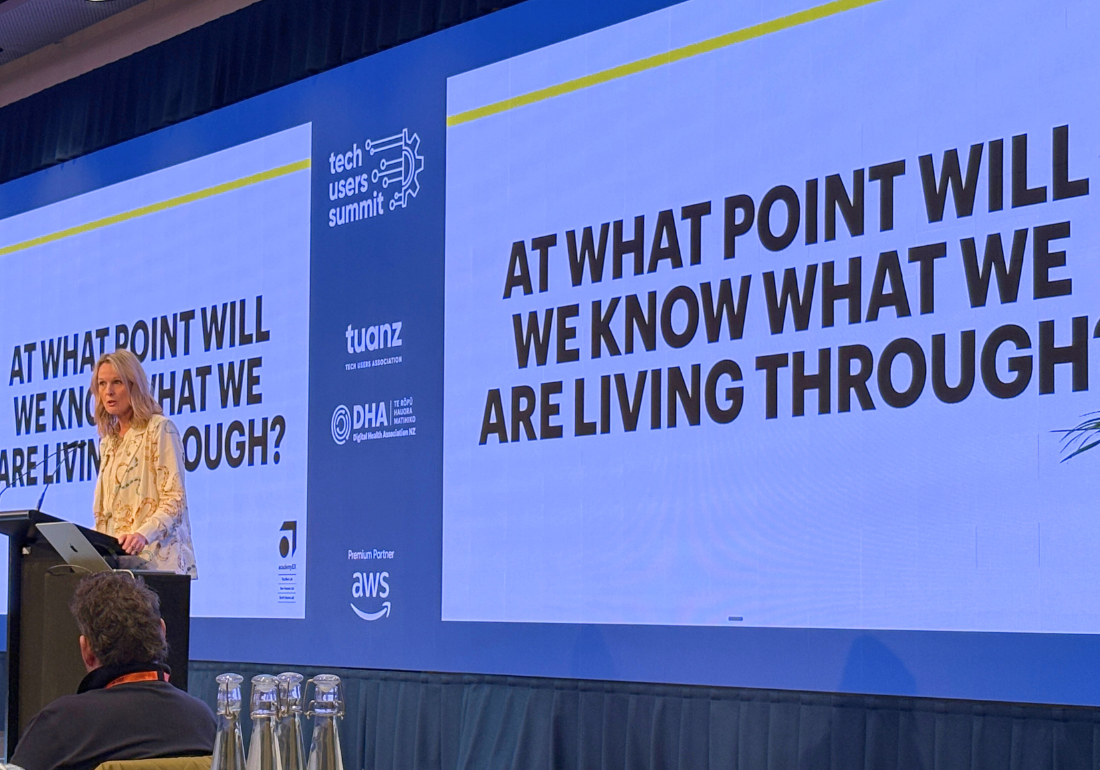Digital as Core Infrastructure

Why We Can't Afford to Keep Building on Shaky Foundations
At the Tech Users Summit 2025, surrounded by some of New Zealand's brightest minds, everyone was grappling with a question that should keep every leader awake at night: when did we decide that digital infrastructure was optional?
The DHA x TUANZ summit's theme, "Digital as Core Infrastructure," wasn't just clever positioning - it was a rallying cry. While we pour billions into roads, bridges, and pipes (and rightly so), Kiwis have somehow found ourselves in a place where the digital threads connecting our entire society can be an afterthought.
The productivity paradox that's slowly strangling us
One of the morning’s keynote speakers, Dr John Roche (Prime Minister's Chief Science Adviser) didn't mince words: New Zealand isn't a wealthy country, and our productivity is shockingly low. He quoted Paul Krugman's warning that "Productivity isn't everything, but in the long run it is almost everything." It's a sobering reminder that our digital deficits aren't just inconvenient… they're existentially threatening to our economic future.
We have the technology. The tools exist. The solutions are proven elsewhere. Yet we can't deploy them at scale. It's like having the blueprints for a bridge but never laying the foundation.
Frances Valintine raised in her keynote something that cut straight to the heart of this: our size keeps us consuming rather than developing or leading. We've become comfortable being followers, importing solutions rather than creating them. But what if our collective could actually be our strength? What if we could make New Zealand the best place to remain human in an increasingly digital world?
The human cost of digital dysfunction
Nowhere is this more stark than in healthcare. The contrast between what Australia has achieved with substantial federal and state investment - precision healthcare, genomics, interoperability - and where we find ourselves is jarring. They're talking about patient-centric strategies powered by sophisticated digital infrastructure. We're still trying to get basic systems talking to each other.
Ian McCrae's presentation was particularly eye-opening, and he showed reports that AI is now outperforming doctors on benchmark accuracy: GPT-5 at 95.8% versus the average doctor at 62%. Yet our healthcare system remains bogged down by operational pressures and fragile starting points that prevent us from deploying technology that could literally save lives.
The devil really is in the details of deployment.
The trust advantage we're squandering
Here's what struck me most: trust is New Zealand's genuine competitive advantage. In a world increasingly sceptical of big tech and digital overreach, we have something money can't buy - a reputation for integrity and human-centred approaches.
But trust without capability is just good intentions. We can be the most trustworthy nation on earth, but if our digital infrastructure can't support innovation, if our systems can't scale, if we can't retain the talent needed to build the future, then what good does that trust do us?
One roundtable comment stuck with me: "Too much planning, much less doing." The room was full of people who absolutely can deploy digital solutions, yet somehow we've created a system that seems designed to prevent deployment rather than enable it. The procurement challenges, the lack of clear channels for government-business collaboration, the absence of agreed definitions around critical concepts like data sovereignty: these aren't insurmountable problems. They're choices we've made through inaction.

The mindset shift
What if we treated digital infrastructure with the same seriousness we apply to physical infrastructure? What if connectivity, interoperability, and digital capability were considered as essential as roads and water systems?
This isn't about technology for technology's sake. It's about recognising that in 2025, digital infrastructure is the foundation upon which everything else - healthcare, education, economic development, social connection - depends.
The Health NZ Digital Investment Plan (DIP), set to be published by the end of 2025, represents a critical test. Will it be another document to gather dust, or will it mark the beginning of the kind of systematic, urgent investment that treats digital capability as the core infrastructure it truly is?
Perhaps Frances Valintine's vision is the key: making New Zealand the best place to remain human. Not through digital resistance, but through thoughtful, human-centred digital design that amplifies our humanity rather than diminishing it. This means building systems that serve people, not the other way around. It means ensuring our digital infrastructure enables equity rather than exacerbating existing divides. It means creating an environment where innovation flourishes because the foundations are solid.
The urgency we can no longer ignore
The conversations at this summit made one thing crystal clear: we're running out of time to treat digital infrastructure as optional. Every month we delay meaningful investment, every procurement process that prioritises process over outcomes, every system that remains fragmented when it could be integrated… These aren't just inefficiencies, they're actively harming New Zealanders.
The question isn't whether we can afford to invest in digital infrastructure. It's whether we can afford not to. [Spoiler: no, we can’t.]
Because in a world where digital capability determines economic competitiveness, healthcare outcomes, and social connection, treating it as anything less than core infrastructure isn't just shortsighted.
It's a betrayal of our responsibility to future generations of New Zealanders.
The summit's theme wasn't aspirational. It was diagnostic. Digital is core infrastructure. Now we need to act like it.







.png)
